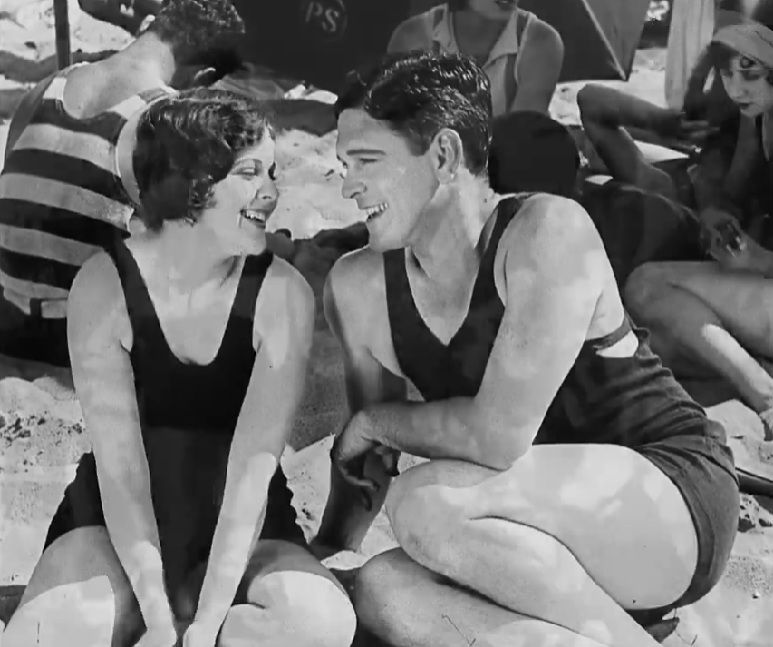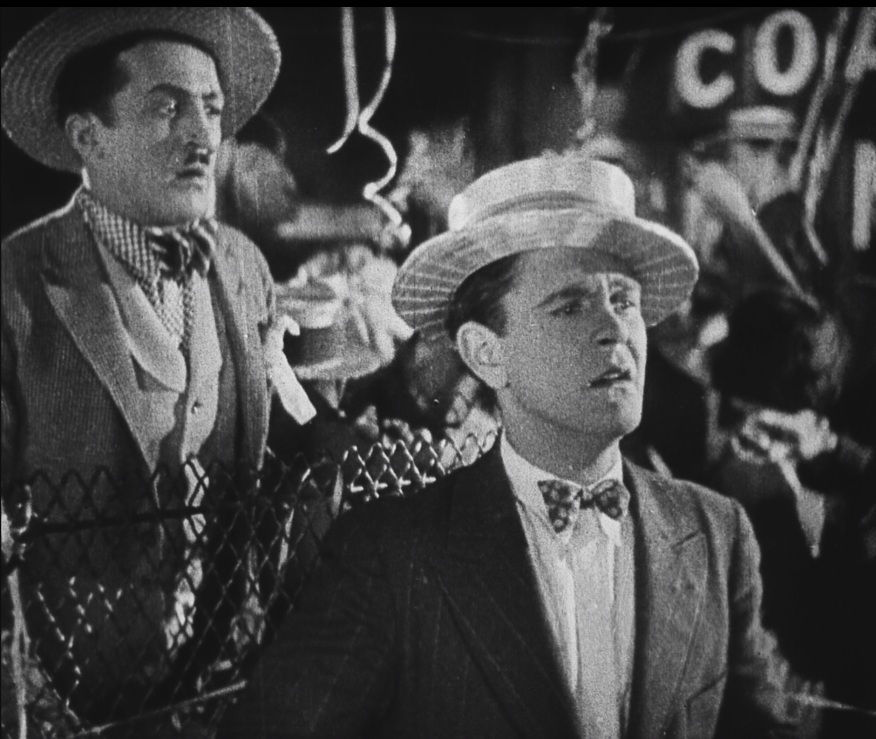July Journeys: Lonesome (1928)
- Samantha Glasser

- Jul 11
- 6 min read
This month we take a vacation with movies featuring characters doing the same.

RODNEY BOWCOCK: Lonesome (1928) tells a simple story about two people who encounter each other in sort of a meet-cute scenario. It’s the story of two New Yorkers that feel lonely and isolated on the eve of a holiday weekend, eventually taking respite in Coney Island. After they meet, they spend a whirlwind date together, eventually becoming separated and despondent over the possibility that they’ve lost each other forever. Glenn Tryon and Barbara Kent portray the fated couple.

SAMANTHA GLASSER: Jim's friend who wears the "Two's Company; Three's a Crowd" pin is young Andy Devine.
RB: He certainly has little resemblance to the Andy Devine that we know from so many later movies, at least to me he doesn’t. I’m sure that others will disagree.
SG: I recognized him, actually, but used IMDB to confirm. He is certainly more slender than usual here.
The film is opulent. I enjoyed spotting background things, like the sign for Lansing Antiques outside the subway entrance, and I imagined what kind of great old things were inside. I also spotted a round Kewpie doll on the prize shelf at the carnival and wanted one.

RB: I also spotted that. I bet it was one of those antique stores that you occasionally find full of pricey 18th and 19th century furniture. The stuff on the carnival prize shelf is more along the lines of the things that fascinate me when I dig through antique stores. Of course, those sorts of things are getting tougher and tougher to find as well, but I digress. This is one of those dream-like silents, which in many ways are my favorites.
SG: The story is very simple and relatable, but its simplicity never gets boring. That's thanks to excellent direction by Paul Fejos. He makes the film into a work of art through his use of unusual angles, double exposures, and a moving camera. In the scenes where Mary and Jim are at work, a clock border frames the scene, counting down the time before they earn their leisure. To illustrate the callers on Mary's switchboard, callers hang over her head in various boxes, chatting away. (In one of them is Louise Emmons, a hag-faced actress I know as the mean orphanage matriarch in Mush and Milk.) At Coney Island, we ride the rides with the couple, rising and falling on the ramps of the roller coaster and sliding down the slide, crashing into the people at the bottom. Fejos, who earned an MD in Hungary before moving to New York in 1922, made more films abroad than in Hollywood, where he landed in 1926. His documentary work was highly praised, and his travels to Peru led him to discovering 18 ancient Incan cities unknown by the modern world.

RB: While the film was portrayed as taking place at Coney Island, in actuality, those scenes were filmed at Venice Beach, which of course bears little resemblance now to what it did at this time, although it is still a bustling tourist attraction. The Jack Rabbit coaster which plays such a critical role in the plot was in Long Beach. It was torn down in 1930, but at one time, it was the second largest coaster in the country.
SG: "The characters were well done and true to life," said Donald Beaton for The Film Spectator. "Just when one begins to wonder how the factory hand can afford to spend so much money on the amusements, there is a shot which reveals that he is running out of money."
RB: I had no issues with this plot point. When you are as infatuated with someone as Jim is, it’s not unusual to throw caution to the wind and determine to put your worries off for the next day.

SG: Lonesome has a canned score, which means it was arranged and recorded at the time the film was made. Revolutionary at the time, canned scores don't age well, in my opinion, because the quality of the sound recording doesn't impart the lushness that a live score gives. However, it is an authentic document of what contemporary scores might have sounded like. In this case, popular tunes were inserted to illustrate some of the scenes, including Irving Berlin's, "Oh, How I Hate to Get Up in the Morning" and "Always." They used the canned score to bookend several talking sequences. I find that part-talkies are distracting and take the viewer out of the story, forcing them to re-acclimate to the film. This one's talking scenes are particularly weak, especially the first one on the beach when we hear that Jim's chosen method of wooing is to spout off a bunch of nonsense about being a rich guy who prefers the crowds of Coney Island to the crowds of the country club. If I were Mary, I'd ditch that bozo. It is obvious throughout the movie that she has no shortage of suitors. But Jim becomes much more appealing when he is silent. Interestingly, in the final scenes when the couple is separated and looking for each other, it seems that Mary is calling for John, not Jim. I wonder if they changed the character's name before they shot the sound sequences.

RB: I can’t really disagree with any of these points, but it did seem to me that Mary was amused by Jim’s obvious fabrications and was kind of teasing him to see how far he’d go with them. It was kind of cute. But, yeah, the talkie sequences were definitely jarring. I’d find myself thinking “Hey! They’re talking!” and being completely taken out of the story.
SG: Glenn Tryon was hired by Hal Roach to replace Harold Lloyd, a big ask. He is an appealing wholesome type, but he doesn't have a megawatt personality. Barbara Kent, a WAMPAs Baby Star of 1927, is similarly pleasant but average, which works well for the simple characters they play in this film.
RB: Tryon was really a jack of all trades. After his acting career stalled out, he found work writing and providing additional dialogue for films, and even doing some directing. He was married for a time to Universal B cutie Jane Frazee. Kent lived until 2011, passing away at the age of 104, outliving all of her fellow baby stars.

SG: I have been enamored with Coney Island ever since I saw an American Masters documentary on the subject which celebrated the democratized fun of the place. There is something quaint and attractive about basic carnival games, simple rides that thrill without terrifying, and swimming in massive bodies of water. We had an amusement park in Columbus called Olentangy Park which I imagine was close to the experience of Coney Island in the 20s. We also had one called Minerva Park which is just a municipality now with a housing development where the attractions once stood. I adore seeing Coney Island in old movies, and it comes up a lot in things like Speedy (1928), On the Town (1949), and Imitation of Life (1959). Most of the old rides are gone but the magic of the place remains in the movies.
RB: Here in southern Ohio, we had our own Coney Island, opening in 1870 and lasting through assorted iterations until it finally closed at the end of the 2023 season. It was quite a shock as the large Sunlite Pool, the largest recirculating pool in North America, was still a very popular regional attraction. It was quite a shock. Some of the old rides relocated to Kings Island in 1973. The original carousel is still there.
SG: I attended a concert there, and thought it was a really cool place. I was sad to hear it closed.

Martin Quigley, founder of Exhibitor's Herald, said, "It is a thoroughly intelligent work and, not in a few spots but throughout, it gives convincing evidence of the imaginative craftsmanship of its director and his ability to reconstruct upon the screen the spirit as well as the shadow of his story."
This story was remade in 1935 starring Zasu Pitts and Hugh O'Connell titled The Affair of Susan. It will be screened on 35mm at Capitolfest this summer.
RB: I’m pretty interested in seeing that. I’m sure it’s quite a different take.
SG: The first time I saw this movie was without the sound sequences, and it lived up to the high praise my friend Rich Finegan heaped upon it. When the Criterion disk came out, I watched it and felt somewhat let down by the way the talking scenes interrupted the flow. This time, it felt more cohesive. It is always a joy to see. Four stars.
RB: I had never seen this movie before, but it reminded me in some ways of another movie that I like very much, The Crowd. Were it not for the talking sequences, this is potentially a five star film. A beautiful simple story. However, with the small missteps, it’s still a very solid and highly recommended four star film.




Comments